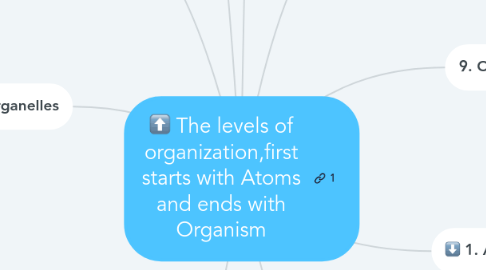The levels of organization,first starts with Atoms and ends with Organism
by Kobi Sparks

1. 6. Tissues
1.1. Connective tissue is usually made of cells and extracellular fibers that hold structures together (tendons), protect them (cartilage), store energy (fat), or produce blood.
1.2. Muscular tissue is made of cells that are organized to shorten and produce force when they contract (smooth skeletal and cordine muscle).
1.3. In biology, tissue is a cellular organizational level between cells and a complete organ. A tissue is an ensemble of similar cells and their extracellular matrix from the same origin that together carry out a specific function. Organs are then formed by the functional grouping together of multiple tissues.
2. 5. Cells
2.1. Cells are the basic structures of all living organisms.
2.2. Cells provide structure for the body, take in nutrients from food and carry out important functions.
2.3. Cells are the basic building blocks of all living things. The human body is composed of trillions of cells. They provide structure for the body, take in nutrients from food, convert those nutrients into energy, and carry out specialized functions.
3. 4. Organelles
3.1. Core organelles are found in virtually all eukaryotic cells.
3.2. They carry out essential functions that are necessary for the survival of cells – harvesting energy, making new proteins, getting rid of waste and so on.
3.3. Core organelles include the nucleus, mitochondria, endoplasmic reticulum and several others.
4. 3. Macromolecule
4.1. term that may refer either to a crystal such as a diamond, in which the atoms are identical and held by covalent bonds (see chemical bond) of equal strength, or to one of the units that compose a polymer.
4.2. Macromolecules such as proteins and nucleic acids are vital to the functions of living cells.
4.3. Lipids are one of the four major groups of organic molecules; the other three being proteins, nucleic acids (DNA), and carbohydrates (sugars). Lipids are made up of the same elements as carbohydrates: carbon, hydrogen, and oxygen.
5. 9. Organism
5.1. A living thing. Like a human and pets.
5.2. Organisms are abiotic, or living, part of the environment.
5.3. Organisms usually have five basic needs. They need air, water, nutrients (food), energy and a place to live.
6. 8. Organ system
6.1. The five most important parts of the organ systems is circulatory, respiratory, digestive, excretory, nervous and endocrine systems.
6.2. Some of the organs in the organ system have an empty tube or pouch.
6.3. The stomach and the instenies are examples of stuff in the organ system.
7. 7. Organs
7.1. Some organ are hollow.
7.2. The eye is an organ.
7.3. Other organ systems in the human body include the immune system and the lymphatic system.
8. 2. Molecule
8.1. 66% of the mass of the human body is made up of oxygen atoms.
8.2. Molecules can have different shapes. Some are long spirals while others may be pyramid shaped.
8.3. A perfect diamond is a single molecule made of carbon atoms.
9. 1. Atom
9.1. Atoms contain a dense nucleus surrounded by a cloud of electrons, which contain a negative charge.
9.2. The interior of the nucleus contains positively charged protons, and almost all atoms' nuclei (with the exception of hydrogen-1) contain neutrally charged neutrons.
9.3. Protons have a positive electrical charge and are found together with neutrons (no electrical charge) in the nucleus of each atom. Negatively charged electrons orbit the nucleus. Atoms are the smallest particles that make up elements.


